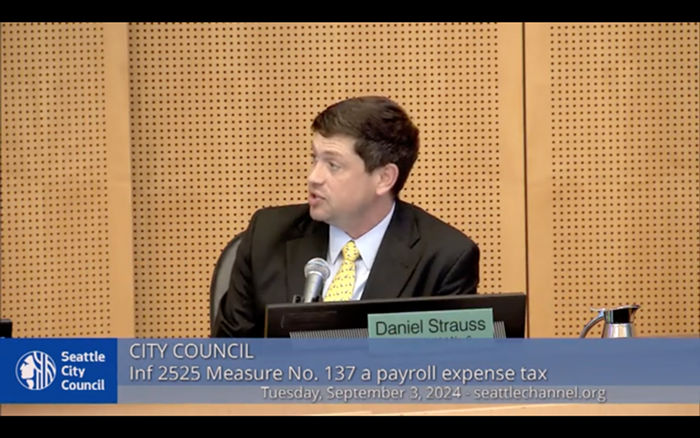
This is part three of a five-part series on rent control in Washington state. In part one, I lay out the need for rent control. In part two, I lay out the case against it. Today, we look at how and why California and Oregon passed rent control laws despite that case. In part four, I ask incumbent and incoming council members what they think about the issue, and wrestle with Council Member Sawant's rent control bill. In the final installment, I take the temperature of key state lawmakers and discuss a potential ballot threat.
Most economists oppose rent control, and some oppose it so much they compare it to a bomb going off in a city.
And yet, in a few years, Oregon went from zero rent controls to establishing the nation’s first statewide rent stabilization law and ending no-cause evictions. Meanwhile, California started with a patchwork of rent stabilization ordinances and then implemented a statewide rent cap while also putting an end to no-cause evictions. New York also passed new rent regulations allowing cities to rein in high rents.
How could politicians and progressive organizers set off such huge rent control “bombs” in their states, despite the woeful cautioneering of economists?
Because they weren’t actually passing rent control.
This year California and Oregon passed “rent stabilization” and “just-cause eviction” laws. These laws don’t freeze rents or force landlords to house demonstrably bad tenants. Rather, they protect tenants from rent gouging and from being kicked out of their homes for no good reason. (Note: I plan to ignore New York for the rest of this post. They’re on the east coast, and they passed different kinds of laws.)
These renter protections were much weaker than strict controls passed in the first half of the century. Nevertheless, throughout the process, supporters faced stiff and well-financed opposition from groups representing realtors, developers, landlords, and the building trades.
Tenant advocates and progressive politicians in both states used similar strategies to overcome that opposition. However, different political pressures were necessary to get the bills over the finish line in each case. To understand how Washington renters could win similar protections, we’ll need to retrace the steps each state took.
The Story in Oregon
Just like everywhere else on the west coast, Oregon had been dealing with an affordable housing crisis for years. Rents were going through the roof all over the state. In 2015, a tenants organization called the Community Alliance of Tenants (CAT) announced a Renters State of Emergency, urging lawmakers to pass eviction reforms and limits to rent increases.
To address the issue, in February of this year, Oregon lawmakers sent Senate Bill 608 over to Governor Kate Brown’s desk for a signature. The bill capped rent increases at 7% plus the cost of inflation, exempting subsidized housing and new construction, i.e. apartments built within the last 15 years. Gone were the days of landlords randomly hiking rents by 100%.
The bill also required landlords to provide a good reason for evicting month-to-month tenants, but it also gave them a few key outs we’ll get into later.
Brown had endorsed the bill in January, and Democratic supermajorities in the statehouse meant—in Oregon, at least—that the bill would likely pass. Landlords groups such as Multifamily NW and the Oregon Rental Housing Association were planning to stay “neutral,” according to the Willamette Week, keeping their negotiations with lawmakers to backrooms.
But getting the bill to this point, according to Katrina Holland, executive director of CAT, started all the way back in 2016.
That year, Representative Rep. Alissa Keny-Guyer, (D-Portland), pushed a housing omnibus bill that would have strengthened eviction protections and declared an emergency for renters. Some of that language ended up in another bill that passed, which set the stage for House Bill 2004 in 2017. That proposal would have further strengthened tenant protections around evictions, but it ran into a roadblock.
Though the bill passed the House, it failed in the Senate thanks to staunch opposition from Senator Rod Monroe, a landlord from progressive Portland.
The following year, former Rep. Shemia Fagan ran a primary challenge against Monroe, promising to champion the bill he’d had killed. She beat the hell out of him—62 to 25—in a three-way race that was seen as “a bellwether in the war between tenants and landlords,” according to the Willamette Week.
The near-win for renter protections in the House in 2017 and Fagan’s decisive victory created a sense of inevitability in 2019. Sen. Fagan introduced the rent stabilization and just-cause bill in the Senate, and Speaker Tina Kotek sponsored the bill in the House, getting leadership on board and vowing to move the bill quickly. Rep. Mark Meek, a Democrat from a Portland suburb who happened to be a realtor and property manager, also helped make the case in the House. The bill sailed through.
A diverse base of support: The key to success for tenant advocates like CAT and the Oregon Housing Alliance (OHA) was building a broad, diverse coalition of supporters who educated their members on the issue and who lobbied the statehouse hard throughout this process.
Their “Fair Shot” agenda included the Urban League, Asian Pacific Network of Oregon, immigrants rights groups, trans rights groups, caregivers, and labor unions such as the service workers, the grocers, the teachers, and the government employees.
“Pressure from this multi-sectoral coalition drove the narrative that doing nothing was not an option," said Holland.
The messaging: Holland said everyone in the coalition was singing the same song about the way to solve the housing crisis, repeating a mantra she referred to as “the trifecta: protect tenants from being evicted, preserve affordable housing, produce new housing.” This agenda is also referred to as the "three Ps” for obvious reasons.
Felisa Hagins, political director for SEIU Local 49, whose support was instrumental in the movement, said her union hammered home this “yes/and” messaging to win over legislators who believed Oregon could only build its way out of the crisis.
Tying rent stabilization to just-cause evictions was also important to gain support, and to ensure lawmakers were presenting a solution that protected and preserved housing. Without just-cause, landlords could kick out tenants and then hike the rents way up. But passing just-cause without rent caps would lead to economic evictions.
Crucially, the statewide scope of the bill allowed supporters to deflect arguments from rural lawmakers about rent hikes only affecting the big cities. According to Holland, renters in rural counties with low vacancy rates expressed greater fear of retaliation from landlords. “In the smaller jurisdictions, landlords know other landlords. If you end up getting blacklisted, you’re out of luck.”
Because the affordability crisis hit everywhere, Holland said her membership included people from all over the political spectrum. “We had people who were diehard Trump supporters advocating for rent control, and we had lefty-lefty super-unicorns out there,” she said. “Everybody is a renter.”
Though landlords and developers were reportedly staying neutral, that didn’t stop realtors and Multifamily NW from lobbying against the bill and causing a stink during hearings. “The realtors were out of control—they got up and acted like nobody had even talked to them about the bill. They were just really awful,” Hagins said.
During testimony, landlords were particularly vocal about their concerns regarding the eviction reforms. “I underestimated the landlords and their ability to whip up fear in people,” Hagins said. “Listening to some landlords, you’d think that every single tenant was a ‘creepy neighbor’ stealing underwear out of laundry rooms and dealing drugs. Eventually we figured out that ‘creepy neighbor’ was code for black or disabled.”
The most effective strategy to combat those arguments, Holland said, was asking follow-up questions. “We’d ask what steps those landlords had taken to remedy those situations. Did they give them notices? Were they really dealing drugs, or were they just a black person wearing a hoodie in the parking lot?”
Not perfect: Holland says the bill was a “huge step in the right direction, but there were some hard pills we had swallow.” Namely, the cap was too high. Initially, the coalition agreed to ask for 5% plus the cost of inflation, and Holland said Speaker Kotek fought for that, “but it became clear that number wasn’t working on her end.”
Moreover, there are some pretty big loopholes in the just-cause rules. First of all, the rules only apply after a year of occupancy. Landlords can also evict for any reason so long as they give tenants 90 days' notice and one month’s rent. Finally, they can refuse to renew a lease if a tenant refuses to heed three written violation notices. The fear here is that landlords will write trumped-up violations and kick people out of there. Those concessions appeared necessary to get buy-in, however.
Nevertheless, the bill is “having the impact we intended,” according to Hagins. Right after the bill was signed, Hagins said she talked to an 80-year-old couple living on the coast in Lincoln City. They were served a no-cause notice, but “several of the people in her complex were able to call the owner and say, ‘No you can’t no-cause evict people,’ which allowed them to stay in their home for another year, at which point they plan to move into assisted living,” she said.
Lessons from California
After the victory in Oregon, in the depths of a massive housing crisis, California Governor Gavin Newsom signed a law that caps rent increases at 5% plus inflation and prohibits landlords from evicting tenants for no reason.
Assemblymember David Chiu (D-San Francisco) and four other legislators led the charge to pass this bill.
Over the phone, Chiu laid out the factors that led to the legislation’s success.
The messaging: Chiu said lawmakers also developed a “comprehensive agenda” based on the "three Ps.”
Since some cities in California can enact limited forms of rent control, lawmakers pitched their bill as “anti-gouging” legislation to protect tenants and preserve affordable housing.
Lawmakers also convincingly tied high rents to increasing homelessness. "That was a very compelling case for colleagues” representing areas reeling from the homelessness crisis, Chiu said.
The negotiations: The messaging created space for rent control’s warring parties to have more productive conversations.
In an attempt to satisfy both parties, lawmakers wrote in a bunch of exemptions that drew key support or repelled deadly opposition to the bill. When lawmakers exempted buildings built within the last 15 years, building trades unions afraid of losing contracts declined to oppose the bill, as did the California Building Industry Association, which represents developers. For a time, pledging to exempt single-family rental homes not owned by corporations kept the California Association of Realtors off their back, though they ended up opposing the bill.
As in Oregon, to help satisfy the tenants groups, lawmakers also tied rent stabilization to a just-cause eviction proposal.
Ultimately, Governor Newsom personally negotiated the “finer details” of the proposal with the California Apartment Association, getting them to agree to that 5% plus inflation rent cap. “We wanted to strike a balance between tenants having some predictability and allowing landlords to earn a fair rate of return, and that number was a number that the apartment associations did not oppose because they agreed it reflected a balance. That ended up being the sweet spot and the magic number that got this done,” Chiu said.
But the Apartment association only came to the table, according to the Los Angeles Times, because of…
The initiative: In the middle of all these negotiations, a group called the AIDS Healthcare Foundation put Proposition 10 on the ballot. The initiative would have greatly expanded rent control, but it went down by 20 points. However, according to the L.A. Times, the campaign was “one of the most expensive initiative battles in California history with more than $104 million in total fundraising.” Undaunted by their huge loss, the AIDS Healthcare Foundation immediately wrote up a streamlined version of the initiative and started the process all over again, with the goal of getting the new initiative on the ballot in 2020.
The opposition was looking down the barrel of another multi-million dollar fight, which made them more open to discussions with lawmakers. “The idea that in 2020 a progressive voting electorate would have another debate over this issue, and because of the historic inaction on this issue, it really focused everyone on seeing if we can get to a deal,” Chiu said.
So, What Did We Learn?
Like almost any big piece of legislation, to win rent stabilization, both California and Oregon needed governors to prioritize the right agenda, one that offered potential benefits to all stakeholders. They also needed passionate and savvy legislators willing to work their networks, broad coalitions of progressive organizations knocking doors and lobbying reps hard, and landlords sympathetic to the cause. It also helped to have a few acute political pressures, such as Sen. Fagan’s win in Oregon and the ballot measure threat in California.
Tomorrow, I’ll look at Seattle, where Council Member Kshama Sawant has introduced a strict rent stabilization proposal she hopes will light a fire under state legislators. And then Friday, we’ll ask around Olympia to see if any state lawmakers are feeling acute pressures, you know, outside of the ones caused by a housing crisis that has gripped the state for several years.



















